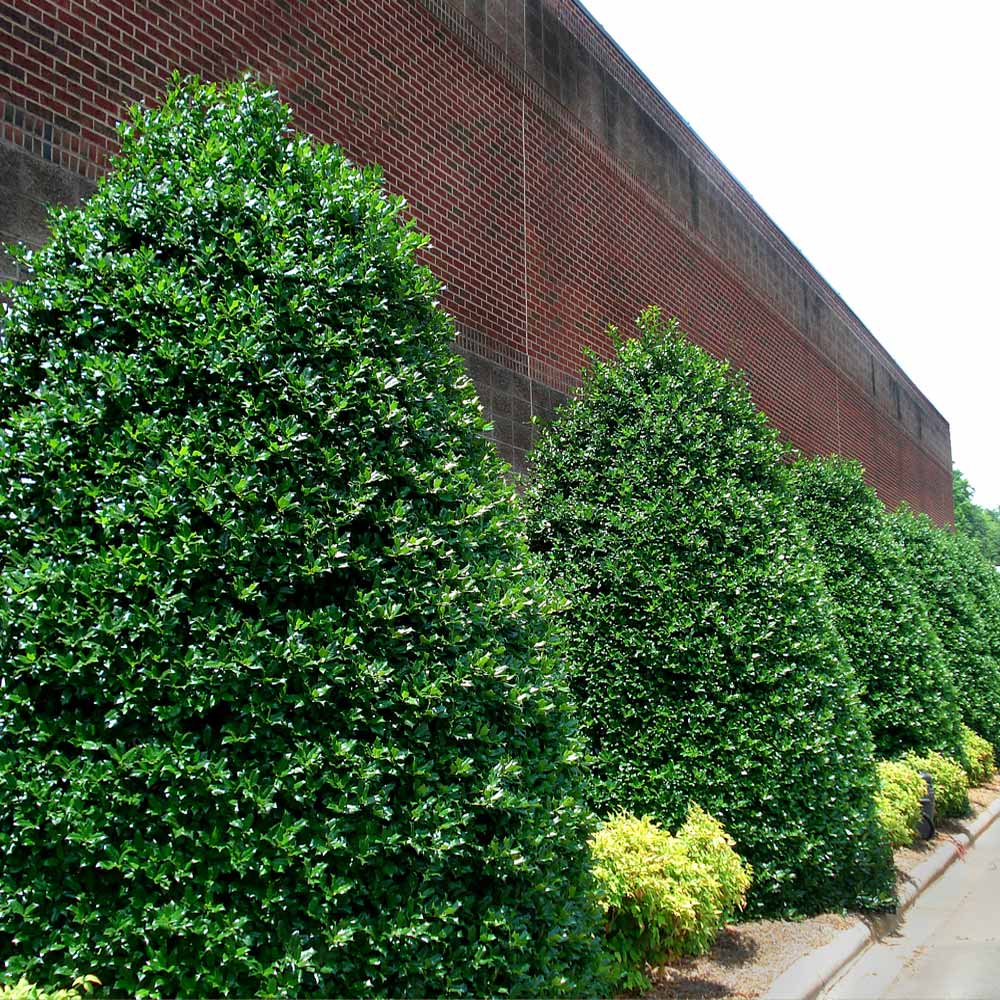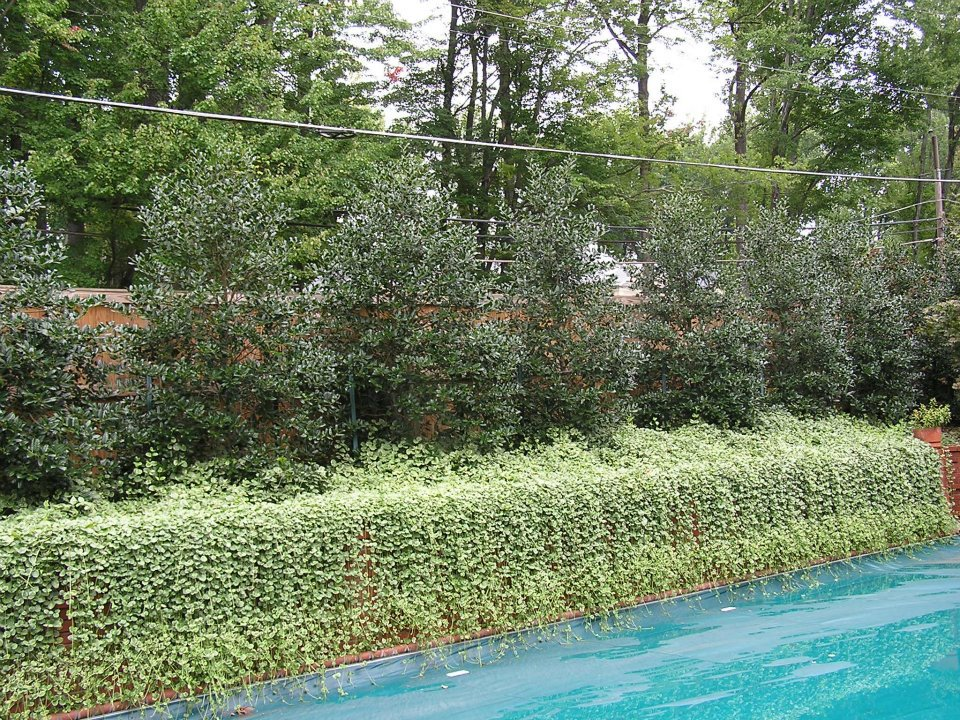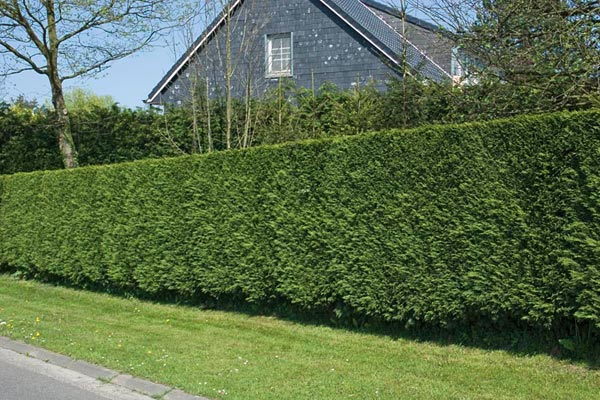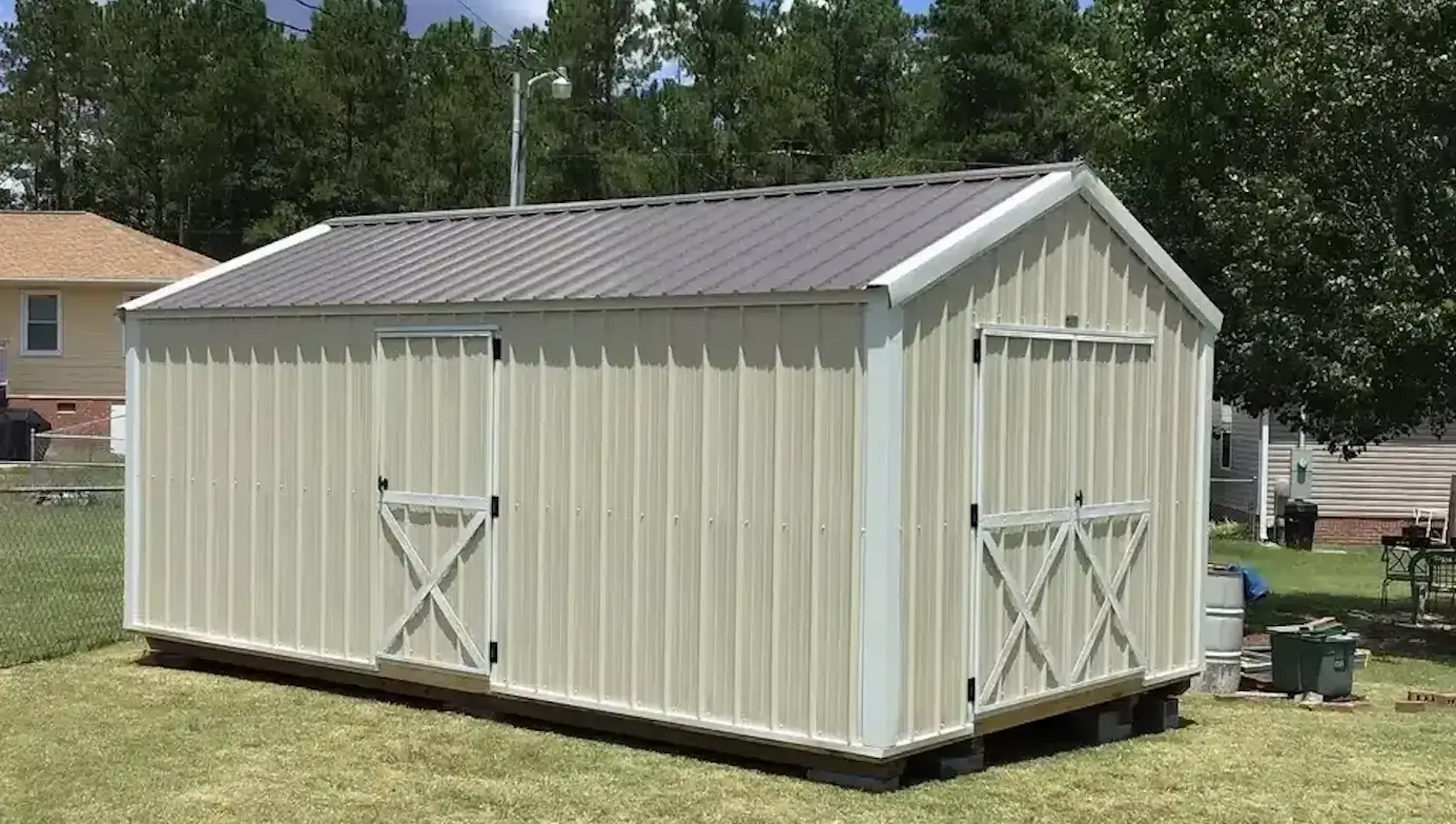- Unlike slow or disease-prone hedging plants, Nellie Stevens Holly is fast-growing (up to 2–3 feet per year), evergreen, and shaped to provide dense, aesthetic privacy in a natural 10–12 foot height perfect for blocking views, wind, and noise.
- This holly is pest and disease resistant, needs little pruning once established, tolerates periods of drought, and can grow in any soil and for all sun.
- Its shiny, evergreen leaves attract birds with bright red berries in winter, adding color and supporting local wildlife when other sources of food are scarce.
- A healthy hedge needs space, good drainage, watering and regular annual pruning to remain dense and attractive.
Some hedge plants, like boxwood, take ages to mature and offer privacy. Others, like Leyland cypress, grow quickly but are plagued by diseases such as cankers and blight, and replacing them can be costly. Deciduous plants do not need all the nutrients in the topsoil and chemically improve it, but do help the nutrient content by shedding leaves in the fall that decompose and put organic matter back into the soil.In winter the leaves drop and the yard looks barren for about 3–5 months, particularly in climates that do not have snow cover, because the leaves don’t decompose until spring.Some evergreens need frequent pruning (arborvitae), sandy poor soil (short pines) or simply do not tolerate the climate and poor soil (cypress).
Nellie Stevens Holly is perfect for growing, as it solves numerous landscaping issues. It grows at a stolid rate, lives for years without being troubled by pests or diseases and retains its dense, glossy leaves all year, in every season providing privacy. It is also tolerant of a variety of soils and climates, which makes it an easier and more reliable option than many other plants.
Growcycle provides guidance to help improve the health of indoor plants. Gardeners can learn about the best supplements, seeds, and chemicals to use, helping their plants grow well and stay free from problems.

Origin and History
The Nellie Stevens Holly-tree is a crossbred tree in the holly family and was first introduced in the early 20th century in America. It’s a hybrid of the English holly (Ilex aquifolium) and the Chinese holly (Ilex cornuta), so it has the best characteristics of both species. It is a hybrid that was unintentionally created by Nellie R. Stevens, a schoolteacher and plant enthusiast in Maryland, when the two parent species were pollinated and she found the seedlings some time later.
Over time, crape myrtles have become a popular landscaping plant in the United States because it is versatile, low-maintenance, and looks great all year. Add to this it's versatility to grow well in so many different climates and soil types, and you can see why it is still a favorite with homeowners and pros.
Benefits of Nellie Stevens Holly
This plant has many benefits, making it a top choice for gardens and landscapes. Here are the main advantages:
1. Provides Year-Round Privacy and Beauty
It is what is called an evergreen, a plant that retains its leaves year-round. The dense dark green foliage provides a natural privacy screen throughout the year. This makes it ideal for creating a hedgerow that will block the view of your neighbors and busy streets. What's more, it has red berries in the winter for some color and interest in a garden that is largely devoid of leaves.
2. Grows Quickly
The Nellie Stevens Holly is not like some plants that start off so small it can take years for them to get tall; instead, it will grow at a rate of 2–3 feet each year once it gets going (assuming you are taking good care of it). This rapid growth rate makes it a good option for someone that is looking for a privacy hedge or a mature tree without a long wait.
3. Easy to Take Care
This is a very low-grown plant. It doesn’t require regular pruning, as it takes on the tidy, gently pyramidal form on its own. In addition, it is very tolerant to various typical garden issues like pests and diseases. After it’s established, it can tolerate dry weather well, so don’t keep watering it all the time.
4. Adapts to Different Conditions
The Nellie Stevens Holly is extremely adaptable and grows in all soil types including sand, clay, and loam provided the area is well-drained. It’s also able to grow in full sun and partial shade, so it will be right at home in plenty of gardens.
5. Helps Wildlife
The plant’s bright red berries lure birds, particularly in wintertime after the food supply has dwindled. It offers shelter, food and habitat for wildlife, which brings the garden to life.
6. Acts as a Wind and Noise Barrier
Grown as a hedge, it provides a dense windbreak, and is good for road or neighbor noise. This makes outdoor areas cooler, calmer and more pleasant.
7. Versatile for Landscaping
The Nellie Stevens Holly works well in many landscaping designs. It can be used as a formal hedge, planted in rows to create a screen, or grown as a single tree to make a statement in the garden. Its versatility means it fits into small gardens, large yards, or even commercial spaces.
Grow and Care of Nellie Stevens Holly Plant
Growing a Nellie Stevens Holly hedge for privacy is simple to grow if you follow the instructions. This plant is popular for creating a thick, evergreen barrier that adds beauty and privacy to any yard. Here Is a simple guide to help grow and maintain a healthy hedge:

Step 1: Pick the Right Spot
- Sunlight: Choose a location where the plants will get plenty of sunlight. They grow best with 4–6 hours of sunlight daily but can also handle partial shade.
- Soil: Nellie Stevens Holly adapts to different soils but prefers well-draining, slightly acidic soil. Avoid areas where water tends to pool, as this can harm the roots.
- Space: Make sure there’s enough room for the plants to grow both upwards and outwards. Keep them away from buildings, fences, or underground pipes.
Step 2: Prepare the Soil
- Clear away grass, weeds, and rocks from the planting area. This reduces competition for nutrients.
- Dig into the soil to loosen it and improve drainage. If the soil is poor, add organic matter like compost to enrich it.
- Test the soil’s pH. Nellie Stevens Holly prefers a pH of 5.5–6.5. If necessary, add lime to increase the pH or sulfur to lower it.
Step 3: Plan the Layout
- Spacing: Space the plants 5–6 feet apart for a single-row hedge. This distance allows them to grow close enough to form a dense screen.
- Plant in two staggered rows for a thicker hedge, with 10 feet between rows. This pattern creates a more layered and solid barrier.
- Use stakes and string to create a straight planting line, ensuring the hedge grows evenly.
Step 4: Plant the Trees
- Dig holes twice as wide and slightly deeper than the plant’s root ball.
- Remove the plant from its container, gently loosen the roots, and place it in the hole. Make sure the top of the root ball is level with the ground.
- Backfill the hole with soil, patting it down gently to remove air pockets.
- Water thoroughly to help the plant settle and ensure the roots make good contact with the soil.
Step 5: Add Mulch and Water Regularly
- Spread a 2–3 inch layer of mulch around the base of each plant. Mulch helps keep the soil moist, prevents weeds, and protects the roots from temperature changes. Keep the mulch a few inches away from the trunk to avoid rot.
- Water deeply right after planting and continue to water regularly, especially during the first year. Consistent moisture helps the roots establish. Once established, the plants become more drought-tolerant but still benefit from occasional deep watering during dry spells.
Step 6: Feed the Plants
- Use a balanced, slow-release fertilizer in early spring and again in late fall. Fertilizing helps the plants grow strong and healthy.
- Avoid over-fertilizing, as this can lead to weak growth or damage to the roots.
Step 7: Prune and Maintain
- Prune the hedge in late winter or early spring to shape it and remove any dead or damaged branches. This also encourages new growth.
- Regularly check for pests or diseases, although Nellie Stevens Holly is highly resistant to most common issues.
- If people want a more formal hedge, trim it lightly each year to maintain the desired shape and height.
Step 8: Be Patient and Watch It Grow
- Nellie Stevens Holly grows about 2–3 feet per year under ideal conditions, so it won’t take long to form a tall, dense privacy hedge.
- With consistent care, the plants will grow into a beautiful, evergreen barrier that blocks views, reduces noise, and adds value to the property.
Create a Privacy Hedge with Nellie Stevens Holly
When creating a privacy hedge with Nellie Stevens Holly, careful planning is essential to ensure both visual appeal and effectiveness. One of the first decisions to make is whether to plant the holly in a single row or a double row.
Single-Row Planting
This is the most common method for creating a hedge. When planting in a single row, ensure that each plant is spaced about 3 to 5 feet apart, depending on how dense people want the hedge to be. While this method creates a good privacy screen, it may not achieve maximum density right away, as the plants will take time to fill in the gaps.
Double-Row Planting
Consider planting in a staggered double row for a thicker, denser privacy screen. In this setup, space the plants about 3 feet apart in each row, with the rows set 3 to 4 feet apart.
This design encourages faster growth to fill in the gaps between the plants, resulting in a fuller, more impenetrable hedge. Double-row planting is especially effective for areas where maximum privacy and windbreak protection are needed.

Determining the Height and Width
Nellie Stevens Holly is a fast-growing plant that can reach a height of 15-25 feet with a width of 8-12 feet. When designing the hedge, consider both the current space and future needs.
- Height: Space plants to reach their maximum height if you are desiring a tall screen to grow quickly. Keep in mind that the height of the hedge will be determined by the amount of space left for growth. If people prefer a smaller, more manageable hedge, the holly can be pruned regularly to maintain a height of about 6 feet to 10 feet. But if it’s height you’re after, and a thick full screen, have faith and let there be little to no pruning too often.
- Breadth: The breadth of hedge should be decided in proportion of space and decoration. Nellie Stevens Holly grows somewhat naturally to 8-12 feet wide, so be sure you have the space for them to sprawl. You can keep the space more compact and the tree at a narrower width by pruning regularly if space is an issue.
Alternative Uses
Although Nellie Stevens Holly is often used as a privacy hedge, it can be used in other landscaping capacities.
- Border Planting - Nellie Stevens Holly is great for use along property lines since it columns nicely and does not typically require pruning. Growers can use it to line the borders of the property, garden, driveway, and so much more, a neat, attractive way to enhance privacy and the beauty of your property.
- Windblock: Nellie Stevens Holly can be used as a natural windblock in locations where windbreak is needed. Its lush leaves block the wind and can stably resist the harsh weather and protect your home, garden, patio from wind. This is especially useful in areas with cold winter winds, or hot, dry, dusty summers.
- Hide Unsightly Views When we see Nellie Stevens Holly, we happen to think of all the hiding spots it creates for ugly buildings and traffic-heavy roads outside our fence. With its dense and lush foliage it gives almost complete block out when fully grown.
Mixing with Other Plants
Try mixing Nellie Stevens Holly with other plants in the landscape to give your design some interest and variety. Combining holly with complimentary plants can enhance its beauty, and add to characteristics such as greater variety in the ecosystem and reducing susceptibility to pests.
- Perennial Flower Beds: Pair with perennial flowering plants such as lavender, roses or daylilies for a lovely contrast against its dark green leaves. These plants provide seasonal interest and draw pollinators such as bees and butterflies.
- Deciduous Shrubs: Holly and deciduous shrubs, such as hydrangeas, spirea, and lilacs, will give you a tiered look. The holly gives the structure; the shrubs the color and texture.
- Groundcover: To finish off the design, plant ground covering plants, such as hostas or creeping thyme at the base of the holly. These ground covers also help to shade out weeds and offer a nice, green carpet effect that looks beautiful next to our taller holly hedge.
Common Mistakes to Avoid
Below are some of the most frequent mistakes people make when planting and caring for Nellie Stevens Holly, and the best ways to help your hedge grow happy and strong: 1.
Planting Too Close Together
- Issue: Planting holly shrubs too close to one another can stunt their growth. When plants grow too close together, their roots battle for space, water and nutrients. This can inhibit growth and weaken the plants. It can also be harmful to airflow, and that can make diseases.
- Solution: Space 3 to 5 feet away so the plants will have enough space to grow well. Two rows for a thick hedge if you must, but not too close.
Ignoring Soil Quality
- Problem: Holly plants grow well only in good soil. The plants will not thrive if the soil is poor, heavy, or doesn’t drain well.
- Solution: Have the soil tested before planting to monitor the pH and nutrient levels. Ensure soil drains well. If it is heavy or clay-like, add compost to the soil to improve drainage. Holly plants prefer slightly acidic to neutral soil, so it might be worth addressing the PH, as well.
Improper Watering
- Issue: Too much or too little watering can damage the holly. Too much water can lead to rotting roots, and too little unsatalary plants can stress out, resulting in yellow or brown leaves.
- Solution: Water the plants frequently, especially the first year, but do not waterlog the soil. Once established, the plants require less water, but check the soil during dry spells. Water deeply and infrequently to promote strong root development.
Neglecting Pruning
- Issue: If holly isn’t pruned it will simply get untidy (straggly, leggy, uneven, or sparse) over time. The plants might also become leggy and not provide the dense privacy screen that was desired.
- Solution: Prune holly in late winter or early spring before it begins to put out new growth. If there are any dead or damaged branches, get rid of those as well as trim back any areas that are growing too tall or wide. Regular pruning keeps the hedge dense and healthy, preserving its look and value as a privacy screen.
Summary
If you want to enhance your yard or garden with the classic element of a beautiful privacy hedge plant Nellie Stevens Holly! It grows fast, is pest and disease resistant, and keeps its thick, green foliage year-round, which makes it an ideal choice for creating a natural privacy screen. The brilliant red berries in winter provide additional beauty in the colder months.
With some good care, such as selection of proper planting location, quality soil and regular pruning, Nellie Stevens Holly can become a densely lush barrier that brings privacy and beauty to any outdoor area. Visit Growcycle to find out more about gardening supplies for the growth of privacy trees.
Disclaimer: This material is for informational purposes only and should not be relied on for legal, medical, financial, or any other form of professional advice.

